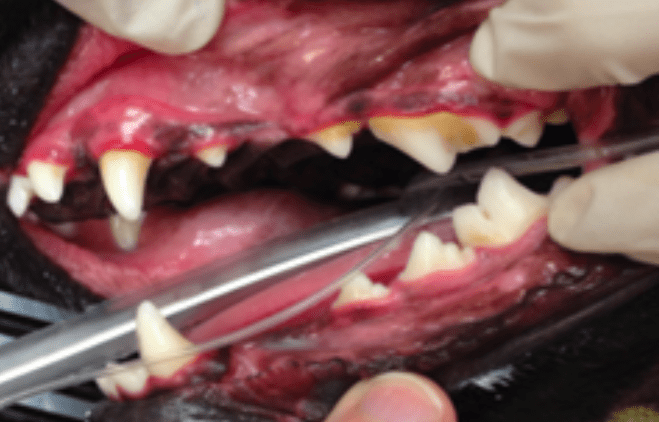Dental Disease
Healthy teeth for a healthy life.We offer free nurse dental checks!
Just as in people, dogs and cats also have dental issues. In fact, it is one of the most common medical conditions seen in vet practices today! It is up to us, the owners of these animals, to help prevent dental disease and watch for signs of dental disease occurring. Bacteraemia (bacteria in the blood stream) can lead to more serious complications with the kidneys and heart. Before humans domesticated cats and dogs, they were hunting animals which means they chewed and tore at bones and meat helping reduce the build up of plaque.
Signs of Dental Disease:
- Buildup of plaque and tartar on the surfaces of the teeth
- Bad breath
- Redness and swelling of the gums which can cause bleeding (gingivitis)
- When severe your dog or cat may also be reluctant to eat and drink
Grade 0 – Clinically Normal
Teeth are perfect.
Grade 1 – Gingivitis
Plaque and minor tartar causing inflammation and swelling of the gums. Ways to help prevent this building up include using oravet chews, plaque off, hexarinse, raw bones, Hills t/d biscuits or petosan toothpaste with fingerbrush.
Grade 2 – Early Periodontitis
Larger amount of plaque and tartar causing inflammation and swelling of the gum, some odour can occur. A scale and polish would be recommended then starting preventable treatment for the future.
Grade 3 – Moderate Periodontitis
Extensive tartar, red and sometimes bleeding gums, gum recession, pocket development, and bad breath. This can cause your dog or cat to not want to eat as the mouth is sore. A scale and polish with dental x-rays would be recommended then starting preventable treatment for the future. Treatment for this may involve extractions.
Grade 4 – Advanced Periodontitis
Scale and polish with dental x-rays is a must at this grade as chronic bacterial infection can destroy the gum, tooth, and bone, and causes increased risk of bacteraemia (bacteria in the blood stream). This can lead to further more serious complications with the kidneys and heart. Treatment for this will involve extractions.
During any dental procedure our gold standard practice is to perform dental x-rays.
Just like us humans, x-rays of the mouth, tell us a great deal regarding the overall health of the teeth and gums, they allow us to focus on specific areas. Equally they also enable us to rule out areas which we’ve previously identified as potential problems.
Dental x-rays often provide substantial evidence to allow these teeth to be left alone. Like normal x-rays, dental radiographs are performed under sedation and are painless for the patient





NORMAL
GRADE 1
GRADE 2
GRADE 3
GRADE 4
Ways to prevent dental disease:
Oravet chews
- Oravet chews are a dental chew treat
- Designed for controlling plaque and tartar build up on the teeth
- Dogs love the taste
- Help maintain gum health
- Aid in keeping your dog’s breath fresh
Raw Bones
- Can help to prevent plaque and tartar build up
- The chewing of the bone helps to scrape off and prevent buildup of tartar
- It can be very therapeutic for your pet
- Large raw bones are best
- Note – Some dogs will shatter bones and ingest the bone pieces themselves – this can cause vomiting, constipation, and even intestinal blockages. Watch for any signs that your dog may be doing this, and seek alternative options.
Hills t/d Dental Biscuits
- T/D is a complete and balanced diet and can be used long term
- Larger biscuit to cover more surface area of the tooth
- Designed for the teeth to sink in to, to help prevent plaque and bacteria build up
Plaque off
- Simply sprinkled onto food daily
- Aids in removing existing tartar buildup and prevents new tartar from forming
- Reduces gum disease and helps with bad breath
- Best used in conjunction with brushing
Tooth Brushing
- Recommended to use doggie toothpaste (Petosan) as it is flavoured especially for your pet to enjoy
- By brushing your pet’s teeth, you can prevent plaque turning to tartar
- Brush gums and teeth gently, finishing with the bottom front teeth
- Focus on the canines and molars as these are most prone to tartar build up
- Combine tooth brushing with T/D diet for best outcome
